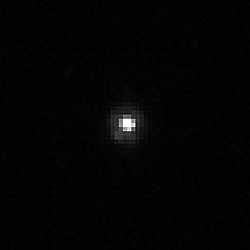astro.wikisort.org - Asteroid
(119979) 2002 WC19 is a twotino, that is, a planetoid in a 1:2 orbital resonance with Neptune. It was discovered on November 16, 2002 at the Palomar Observatory. If its derived diameter is correct it would have a higher density than Pluto, which is unusual as it appears to be much smaller than the expected size at which a Kuiper belt object usually becomes solid.
 2002 WC19 and its satellite imaged by the Hubble Space Telescope in 2007 | |
| Discovery | |
|---|---|
| Discovered by | Palomar Observatory |
| Discovery date | 16 November 2002 |
| Designations | |
MPC designation | (119979) 2002 WC19 |
Minor planet category | Twotino[1][2] binary |
| Orbital characteristics[3] | |
| Epoch 13 January 2016 (JD 2457400.5) | |
| Uncertainty parameter 3 | |
| Observation arc | 3978 days (10.89 yr) |
| Aphelion | 60.732 AU (9.0854 Tm) |
| Perihelion | 35.289 AU (5.2792 Tm) |
Semi-major axis | 48.010 AU (7.1822 Tm) |
| Eccentricity | 0.26498 |
Orbital period (sidereal) | 332.67 yr (121,507 d) |
Mean anomaly | 316.02° |
Mean motion | 0° 0m 10.666s / day |
| Inclination | 9.1746° |
Longitude of ascending node | 109.7547° |
Time of perihelion | ≈ 5 November 2056[4] ±3 days |
Argument of perihelion | 44.356° |
| Known satellites | 1 (81 km)[5] |
| Earth MOID | 34.3056 AU (5.13204 Tm) |
| Jupiter MOID | 29.9229 AU (4.47640 Tm) |
| Physical characteristics | |
| Dimensions | 338 km[5] |
| Mass | (7.7±0.5)×1019 kg[5] |
Mean density | 1.97 g/cm3[5] |
Geometric albedo | 0.07 (expected from theory)[6] |
Absolute magnitude (H) | 4.9 |
Knowing how many twotinos there are may reveal whether Neptune took roughly 1 million or 10 million years to migrate about 7 AU from its birth location.[7]


Satellite
A natural satellite was reported to be orbiting (119979) 2002 WC19 on February 27, 2007. It is estimated to be 4092±94 km from the primary, with an orbital period of 8.403±0.001 days, an eccentricity of 0.21±0.05 and an inclination of 24.0°±0.7°. Assuming similar albedos, it is a quarter the diameter of its primary, or around 81 kilometres (50 mi) in diameter.[5]
References
- Marc W. Buie (2004-12-14). "Orbit Fit and Astrometric record for 119979". (using 61 of 65 observations) SwRI (Space Science Department). Retrieved 2009-03-04.
- "MPEC 2009-C70 :Distant Minor Planets (2009 February 28.0 TT)". Minor Planet Center. 2009-02-10. Retrieved 2009-03-04.
- "JPL Small-Body Database Browser: 119979 (2002 WC19)" (2012-11-06 last obs; arc: 10.89 years). Retrieved 7 April 2016.
- JPL Horizons Observer Location: @sun (Perihelion occurs when deldot changes from negative to positive. Uncertainty in time of perihelion is 3-sigma.)
- Wm. Robert Johnston (27 May 2019). "(119979) 2002 WC19". Johnston's Archive. Retrieved 2020-10-16.
- Mike Brown, How many dwarf planets are there in the outer solar system? Archived October 18, 2011, at the Wayback Machine
- Ron Cowen (2009-01-04). "On the Fringe". ScienceNews. Archived from the original on 7 January 2010. Retrieved 2010-01-04.
External links
На других языках
[de] (119979) 2002 WC19
(119979) 2002 WC19 ist ein großes transneptunisches Objekt, welches bahndynamisch als Resonantes KBO (Twotino) oder auch allgemeiner als Distant Object eingestuft wird. Aufgrund seiner Größe ist der Asteroid ein Zwergplanetenkandidat. Er besitzt einen Mond, der etwa ein Viertel des Durchmessers des Mutterasteroiden aufweist.[8]- [en] (119979) 2002 WC19
[ru] (119979) 2002 WC19
(119979) 2002 WC19 — транснептуновый объект с орбитой, расположенной за орбитой Плутона, в поясе Койпера. Он был обнаружен в Паломарской обсерватории 16 ноября 2002 года.Другой контент может иметь иную лицензию. Перед использованием материалов сайта WikiSort.org внимательно изучите правила лицензирования конкретных элементов наполнения сайта.
WikiSort.org - проект по пересортировке и дополнению контента Википедии

